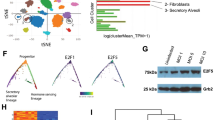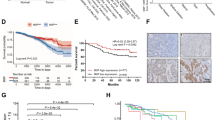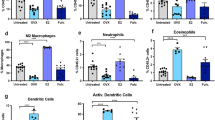Abstract
Transformation of mammary epithelial cells (MECs) from the normal to the neoplastic stage requires the dysregulation of tumor suppressor genes and proto-oncogenes. Tip30 is a tumor suppressor that can inhibit estrogen receptor-mediated transcription in MECs, but its role in MEC proliferation remains unknown. Here, we show that deleting the Tip30 gene leads to ductal hyperplasia in mouse mammary glands early in life and extensive mammary hyperplasia with age. Tip30−/− mammary glands transplanted into wild-type mammary fat pads also display mammary trees with extensive ductal hyperplasia. Strikingly, Tip30 deletion promotes proliferation of primary MECs and results in rapid immortalization of MECs in vitro relative to wild-type cells. Gene array analysis identified significant increases in the expression of mammary epithelial growth factors Wisp2 and Igf-1 in Tip30−/− cells. Knockdown of either Wisp2 or Igf-1 using short interfering RNA dramatically inhibited proliferation of Tip30−/− cells. Together, these results suggest that Tip30 is an intrinsic and negative regulator of MEC proliferation partly through the inhibition of Wisp2 and Igf-1 expression, and its absence in the mammary gland may predispose MECs to neoplastic transformation.
This is a preview of subscription content, access via your institution
Access options
Subscribe to this journal
Receive 50 print issues and online access
$259.00 per year
only $5.18 per issue
Buy this article
- Purchase on SpringerLink
- Instant access to full article PDF
Prices may be subject to local taxes which are calculated during checkout






Similar content being viewed by others
References
Banerjee S, Saxena N, Sengupta K, Tawfik O, Mayo MS, Banerjee SK . (2003). WISP-2 gene in human breast cancer: estrogen and progesterone inducible expression and regulation of tumor cell proliferation. Neoplasia 5: 63–73.
Cardiff RD, Anver MR, Gusterson BA, Hennighausen L, Jensen RA, Merino MJ et al. (2000). The mammary pathology of genetically engineered mice: the consensus report and recommendations from the Annapolis meeting. Oncogene 19: 968–988.
Dimri GP, Martinez JL, Jacobs JJ, Keblusek P, Itahana K, Van Lohuizen M et al. (2002). The Bmi-1 oncogene induces telomerase activity and immortalizes human mammary epithelial cells. Cancer Res 62: 4736–4745.
Hewitt RE, Brown KE, Corcoran M, Stetler-Stevenson WG . (2000). Increased expression of tissue inhibitor of metalloproteinases type 1 (TIMP-1) in a more tumourigenic colon cancer cell line. J Pathol 192: 455–459.
Ito M, Jiang C, Krumm K, Zhang X, Pecha J, Zhao J et al. (2003). TIP30 deficiency increases susceptibility to tumorigenesis. Cancer Res 63: 8763–8767.
Jiang C, Ito M, Piening V, Bruck K, Roeder RG, Xiao H . (2004). TIP30 interacts with an estrogen receptor alpha-interacting coactivator CIA and regulates c-myc transcription. J Biol Chem 279: 27781–27789.
King FW, Shtivelman E . (2004). Inhibition of nuclear import by the proapoptotic protein CC3. Mol Cell Biol 24: 7091–7101.
Lee H, Park DS, Razani B, Russell RG, Pestell RG, Lisanti MP . (2002). Caveolin-1 mutations (P132L and null) and the pathogenesis of breast cancer: caveolin-1 (P132L) behaves in a dominant-negative manner and caveolin-1 (−/−) null mice show mammary epithelial cell hyperplasia. Am J Pathol 161: 1357–1369.
Lee LW, Zhang DH, Lee KT, Koay ES, Hewitt RE . (2004). CC3/TIP30 expression was strongly associated with HER-2/NEU status in breast cancer. Ann Acad Med Singap 33: S30–S32.
Ma ZQ, Chua SS, DeMayo FJ, Tsai SY . (1999). Induction of mammary gland hyperplasia in transgenic mice over-expressing human Cdc25B. Oncogene 18: 4564–4576.
Medina D . (2002). Biological and molecular characteristics of the premalignant mouse mammary gland. Biochim Biophys Acta 1603: 1–9.
Medina D, Kittrell F . (2000). Establishment of mouse mammary cell lines. In: Ip MM, Ash BB (eds). Methods in Mammary Gland Biology and Breast Cancer. Kluwer Academic/Plenum Publishers: New York, pp 137–145.
Medina D, Kittrell FS . (1993). Immortalization phenotype dissociated from the preneoplastic phenotype in mouse mammary epithelial outgrowths in vivo. Carcinogenesis 14: 25–28.
Nonet GH, Stampfer MR, Chin K, Gray JW, Collins CC, Yaswen P . (2001). The ZNF217 gene amplified in breast cancers promotes immortalization of human mammary epithelial cells. Cancer Res 61: 1250–1254.
Oh A, List HJ, Reiter R, Mani A, Zhang Y, Gehan E et al. (2004). The nuclear receptor coactivator AIB1 mediates insulin-like growth factor I-induced phenotypic changes in human breast cancer cells. Cancer Res 64: 8299–8308.
Radice GL, Ferreira-Cornwell MC, Robinson SD, Rayburn H, Chodosh LA, Takeichi M et al. (1997). Precocious mammary gland development in P-cadherin-deficient mice. J Cell Biol 139: 1025–1032.
Saxena N, Banerjee S, Sengupta K, Zoubine MN, Banerjee SK . (2001). Differential expression of WISP-1 and WISP-2 genes in normal and transformed human breast cell lines. Mol Cell Biochem 228: 99–104.
Shillingford JM, Miyoshi K, Flagella M, Shull GE, Hennighausen L . (2002). Mouse mammary epithelial cells express the Na-K-Cl cotransporter, NKCC1: characterization, localization, and involvement in ductal development and morphogenesis. Mol Endocrinol 16: 1309–1321.
Shtivelman E . (1997). A link between metastasis and resistance to apoptosis of variant small cell lung carcinoma. Oncogene 14: 2167–2173.
Ullrich RL, Bowles ND, Satterfield LC, Davis CM . (1996). Strain-dependent susceptibility to radiation-induced mammary cancer is a result of differences in epithelial cell sensitivity to transformation. Radiat Res 146: 353–355.
Varambally S, Dhanasekaran SM, Zhou M, Barrette TR, Kumar-Sinha C, Sanda MG et al. (2002). The polycomb group protein EZH2 is involved in progression of prostate cancer. Nature 419: 624–629.
Wang J, Xie LY, Allan S, Beach D, Hannon GJ . (1998). Myc activates telomerase. Genes Dev 12: 1769–1774.
Xiao H, Tao Y, Greenblatt J, Roeder RG . (1998). A cofactor, TIP30, specifically enhances HIV-1 Tat-activated transcription. Proc Natl Acad Sci USA 95: 2146–2151.
Xu X, Wagner KU, Larson D, Weaver Z, Li C, Ried T et al. (1999). Conditional mutation of Brca1 in mammary epithelial cells results in blunted ductal morphogenesis and tumour formation. Nat Genet 22: 37–43.
Zhang S, Li X, Burghardt R, Smith R, Safe SH . (2005). Role of estrogen receptor (ER) alpha in insulin-like growth factor (IGF)-I-induced responses in MCF-7 breast cancer cells. J Mol Endocrinol 35: 433–447.
Zhang Y, Karas M, Zhao H, Yakar S, LeRoith D . (2004). 14-3-3sigma mediation of cell cycle progression is p53-independent in response to insulin-like growth factor-I receptor activation. J Biol Chem 279: 34353–34360.
Zhao J, Ni H, Ma Y, Dong L, Dai J, Zhao F et al. (2006). TIP30/CC3 expression in breast carcinoma: relation to metastasis, clinicopathologic parameters, and P53 expression. Hum Pathol 38: 293–298.
Acknowledgements
We thank Drs C-Wu and Y Qin for their histopathological expertise, J Wahl for providing E-cadherin antibodies. We also thank C Eischen for her generous help and advice and S Haslam for critical reading of the paper. This work was supported by grants from National Institute of Health Grants DK066110-01 and American Cancer Society Grant RSG0216501GMC to HX. WT was supported by Department of Defense postdoctoral traineeship award, DAMD17-001-0361. JP was supported by an NIH graduate student fellowship.
Author information
Authors and Affiliations
Corresponding author
Additional information
Supplementary Information accompanies the paper on the Oncogene website (http://www.nature.com/onc).
Supplementary information
Rights and permissions
About this article
Cite this article
Pecha, J., Ankrapp, D., Jiang, C. et al. Deletion of Tip30 leads to rapid immortalization of murine mammary epithelial cells and ductal hyperplasia in the mammary gland. Oncogene 26, 7423–7431 (2007). https://doi.org/10.1038/sj.onc.1210548
Received:
Revised:
Accepted:
Published:
Issue date:
DOI: https://doi.org/10.1038/sj.onc.1210548
Keywords
This article is cited by
-
Decreased TIP30 promotes Snail-mediated epithelial–mesenchymal transition and tumor-initiating properties in hepatocellular carcinoma
Oncogene (2015)
-
Tip30 controls differentiation of murine mammary luminal progenitor to estrogen receptor-positive luminal cell through regulating FoxA1 expression
Cell Death & Disease (2014)
-
Contribution of TIP30 to chemoresistance in laryngeal carcinoma
Cell Death & Disease (2014)
-
TIP30 loss enhances cytoplasmic and nuclear EGFR signaling and promotes lung adenocarcinogenesis in mice
Oncogene (2013)
-
CC3/TIP30 affects DNA damage repair
BMC Cell Biology (2010)



